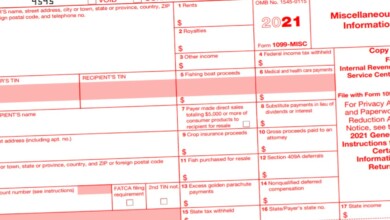1099-INT Form
The 1099-INT form is an essential document provided by financial institutions to individuals who have earned certain types of income other than wages, salaries, or tips. This article will explain in detail what the 1099-INT form is, why it's important, how to read it, and how to use it when filing your taxes.

Contents
The 1099-INT form is a version of the Internal Revenue Service (IRS) 1099 form that’s used to report interest income. Banks and other financial institutions use this form to report the interest they’ve paid to investors over the course of the tax year. It’s important to note that a separate 1099-INT form is provided for each account that has earned more than $10 in interest during 2024.
Why is the 1099-INT Form Important?
The 1099-INT form is crucial for two primary reasons:
- For the IRS: It helps the IRS track the interest income you’ve received throughout the year, ensuring that you’re paying the appropriate amount of taxes on that income. The IRS matches the information provided on the 1099-INT forms with the information you report on your tax return to ensure accuracy.
- For the taxpayer: It provides you with a clear record of the interest income you’ve earned, which you’ll need to report when you file your taxes. If you don’t include this income on your tax return, you could face penalties from the IRS.
Understanding the Boxes on the 1099-INT Form
The 1099-INT form for 2024 contains several boxes, each of which reports a different type of information related to your interest income.
- Box 1 reports your total taxable interest income for the year, not including any federal tax withheld.
- Box 2 reports interest penalties you were charged during 2024.
- Box 3 reports interest earned on U.S. Savings Bonds, Treasury obligations, and other government securities. This may be exempt from state or local taxes.
- Box 4 reports any federal tax withheld from your interest income.
- Box 5 reports investment expenses. This box is generally not applicable for most taxpayers as of tax year 2023.
- Box 6 reports any foreign tax paid.
- Box 7 reports foreign country or U.S. possession where tax was withheld at its source.
- Box 8 reports tax-exempt interest. This is interest from a U.S. obligation that is tax-exempt at the federal level.
- Box 9 reports specified private activity bond interest dividends. This interest is taxable and must be reported on your tax return.
- Box 10 reports the market discount on a bond, which is generally not applicable for most taxpayers.
- Box 11 is for bond premium on Treasury obligations.
- Box 12 is for bond premium on tax-exempt bond.
- Box 13 reports the amount of accrued market discount.
- Box 14 reports the state.
- Box 15 reports the state identification number.
- Box 16 reports the state tax withheld.
Form 1099-INT (Interest Income) is an information return that reports interest payments received from financial institutions that count as income. Banks are required to file this tax form to report how much was paid in reportable during the tax year. The 1099-INT also reports any tax withheld along with the backup withholding if it was subjected to the taxpayer that’s the 1099-INT is furnished.
The same as other information returns that report income, or any other 1099, the taxpayer that received it must attach the form to their federal income tax returns. If not attached, the tax return won’t have everything that’s needed and the taxpayer will have to amend the return at some point.
How Form 1099-INT is filed?
If you’ve made interest payments that exceed $10 during the tax year, you must file Form 1099-INT to report this to the taxpayer. You’ll also file the same copy for Internal Revenue Service Center and the state tax department. There won’t be any additional work for these copies as all three forms will be the same.
You can start filling out the 1099-INT online and file it and print out a paper copy. However, this isn’t e-filing so you will need to mail 1099 with 1096 Form to the IRS. You will also need to mail it to the state tax department, but how you give it to the recipient doesn’t matter.
Breakdown of the 1099-INT Form Boxes
| Box | Description |
|---|---|
| 1 | Total taxable interest income |
| 2 | Interest penalties |
| 3 | Interest on U.S. Savings Bonds and Treasury obligations |
| 4 | Federal tax withheld |
| 5 | Investment expenses |
| 6 | Foreign tax paid |
| 7 | Foreign country or U.S. possession |
| 8 | Tax-exempt interest |
| 9 | Specified private activity bond interest dividends |
| 10 | Market discount on a bond |
| 11 | Bond premium on Treasury obligations |
| 12 | Bond premium on tax-exempt bond |
| 13 | Accrued market discount |
| 14 | State |
| 15 | State identification number |
| 16 | State tax withheld |
Reporting Information from the 1099-INT Form on Your Tax Return
| 1099-INT Box | Corresponding Form 1040 Line |
|---|---|
| 1 | Taxable Interest |
| 8 | Tax-Exempt Interest |
| 6 | Foreign Tax Credit |
Can I e-file Form 1099-INT?
Form 1099-INT can be filed electronically, but you need to utilize the services of a tax preparation company. While e-filing is a great option that doesn’t take a lot of time and requires much effort, you often need to pay for it. When it involves tax forms, you’ll have to pay.
When is 1099-INT due?
Form 1099-INT has a deadline that you must prepare and file with the aforementioned places and the recipient. The deadline to file Form 1099=-INT is January 31 with the recipient and February 28 or March 31 for the IRS and state tax department, depending on how you choose to file. You get more time to complete this tax obligation with e-filing/
What are the penalties for late filing 1099-INT?
Like other information returns, you are subject to late-filing penalties when you’re late doing it so. The penalties start from $50 per violation and increase to $110 after 30 days from the due date. If a taxpayer chooses to willfully ignore to file the 1099-INT, the penalty increases to $500. When filed on time, you don’t need to worry about these. There is also a maximum penalty amount that’s upwards of $500,000 for companies. For example, if there were 2,000 wilfully ignored 1099-INTs, the penalty would be $1 million, but with the limit, it can’t surpass $500,000.





